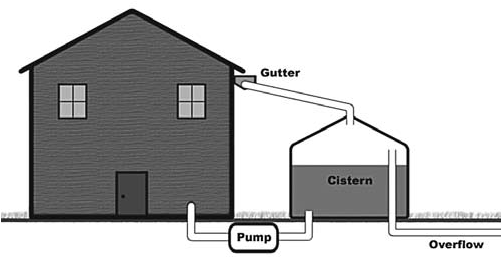5. Permeable Pavements | 6. Cisterns | 7. Rain Barrels
Cisterns
 |
| Diagram of Aboveground Cistern System |
What are Cisterns?
Cisterns are large tanks that store rainwater collected from impervious surfaces for domestic uses or for consumption.
Why use Cisterns?
The water collected in cisterns can be used for two purposes: domestic use and consumption. Some domestic uses of the water are flushing toilets, watering gardens, cleaning laundry, and washing cars. Using rainwater to perform these functions can reduce the costs associated with the delivery of potable water from traditional supply systems (i.e. normal tap water).
Cisterns can also be used to collect rain water for consumption. This application is appropriate in areas where there is not a constant supply of potable water, such as rural agricultural areas or at backwoods camp sites. However if rainwater stored in these tanks is consumed, the cistern design must ensure that the water is contaminant free to prevent health issues associated with consumption of toxic chemicals.
How do they manage stormwater?
Cisterns help manage stormwater by reducing peak runoff volumes. One benefit of this is that less water enters the storm sewer systems which means less water is delivered to a treatment facility. This lowers the cost, energy, and resources associated with cleaning this water. An ecological benefit that comes with reduced runoff volumes is that the streams that convey this storm water are less like to become eroded by high flow rates and polluted by the surface contaminants that the storm water contains.
Cisterns work by collecting the rainfall that lands on impervious surfaces. Rooftops are the best impervious surface for this application because surfaces like parking lots and driveways collect petroleum products like motor oil that should be kept out of the cisterns. Also, since rooftops are elevated the cisterns can be filled gravitationally. This technique is not as easy when collecting water from roadways. Rain water falls on the rooftop, travels downhill into the gutter, and then eventually travels to ground level through downspouts. Before it enters the cistern, large debris is filtered from the water by mesh screens. Cisterns are often concealed underground, to mitigate the effects of temperature changing, and limit the access of insects and animals.
Are there any other benefits to having Cisterns?
An obivous benefit provided by cisterns is an additional supply of water. Instead of rainwater being routed away quickly, it is retained for later use. This is extremely beneficial in areas that do not have a constant water supply, or in areas where a clean water source is miles away. This on-site collection and storage lowers the land owner's water bill, and also helps the global community by reducing the amount of fossil fuel energy used to supply water from a remote site.
Are there any constraints / design considerations?
There are a few features that can be included within a cistern systems to maximize efficiency. First, there should by an overflow pipe which prevents the cistern from filling above a certain depth. Also, the cistern should be lined with a plastic membrane to prevent any part of the tank structure from fracturing and dissolving into the water. Additionally, a pump may want to be included to provide sufficient pressure to deliver the water wherever it is needed, especially if the cistern is at lower elevation (i.e. underground). The tank should also be cylindrical, as it has a high strength to weight ratio when filled with water.
If the retained water is to be consumed, then designing the cistern system must be done very carefully. Contamination must be prevented during every component of the system. First, the rooftop which is collecting the rainwater should be made of galvanized steel or aluminum because these smooth surfaces prevent the buildup of organic solids. Also, the area around the roof should be devoid of trees to prevent leafs, twigs, insects and bird feces from landing on the roof. Next, the gutters and downspouts used should be lined with the same steel/aluminum material for the same reason as the roof. Before the water enters the cistern, it should be filtered either by using either a sedimentation tank or more preferably a sand or charcoal filter. Sometimes, mechanisms are included that divert the first flush of stormwater from entering the cistern. The reason for this is that the first flush usually has the highest concentration of pollutants, which are best kept out of the tank. Finally, it is recommended that a chlorinator is included in the design to kill any microbial pathogens.





